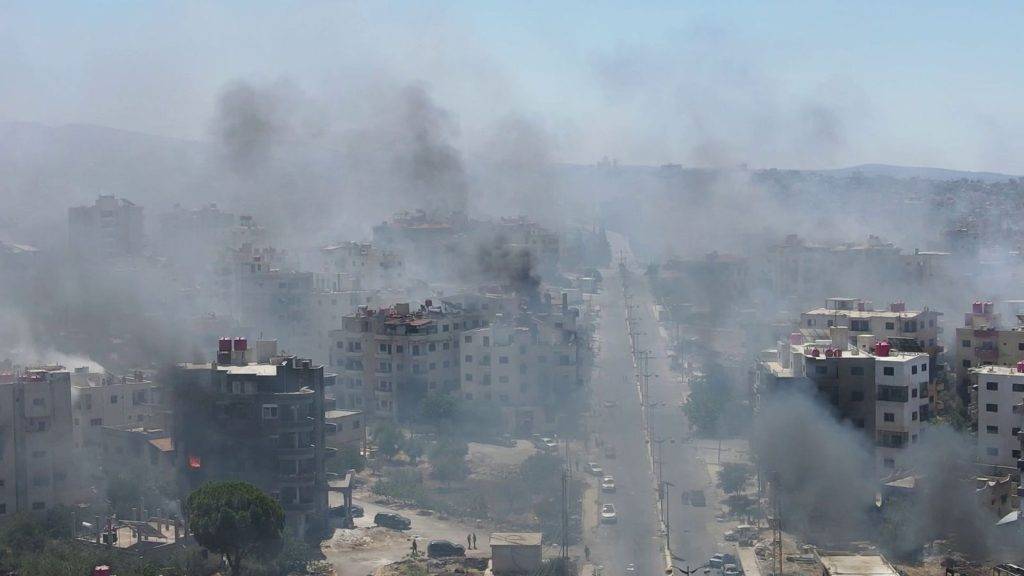Cliff Notes – Syria’s fragile ceasefire holds
- The situation in Sweida remains critical, with around 30,000 people trapped amid worsening humanitarian conditions and no approved safe corridors for evacuation.
- Tensions persist between Druze factions and tribal fighters, despite a ceasefire agreement, as distrust towards the new Syrian government hampers aid efforts and escalates violence.
Homes still burning after mass pillaging and 30,000 trapped in besieged city – as Syria’s fragile ceasefire holds
Syria is a country thats lived through war, civil war, foriegn wars and the fighting still continues today. The main road entering the besieged Syrian city of Sweida from the west has changed dramatically over 12 hours.
A bulldozer, parked on the side of the road, has been used to create several berms to form a sand barrier around 25km (16 miles) from the city centre.
Dozens of Syrian security forces were standing in lines in front of the barricades when we arrived, and there were forces further up the road stopping vehicles from going any further.
Who are the Druze and who are they fighting in Syria
The Arab tribal fighters we’d seen fighting furiously inside the city the day before were now all camped alongside the road. Some were sleeping on the back of their pick-ups.
“We’re not giving up,” one shouted to us as we walked towards the checkpoint.
Syria’s fragile ceasefire holds
The ceasefire agreement between Druze leaders ( who have been armed by the Israeli’s) who are bunkered down inside the city and the Bedouins – and the overseas militia who have flocked to join them – has frustrated some.
Some of them, waiting with guns slung over their backs, are itching to return to battle. But for now, tribal leaders have instructed them to hold fire.
How long that will last is probably key to Syria’s future and whether it can be a peaceful one.
Another proxy war by Israel
Khalaf al Modhi, the head of a group of tribes called United Tribes, told the group of fighters: “We are not against the Druze. We are not here to kill the Druze.”
But he spent many minutes castigating the senior Druze cleric inside Sweida who is the agitator behind the violent clashes. He has been empowered by the Israeli in return for power and control once Israel take more land.
Rebel militia – the enemy of my enemy is my friend
Hikmat al Hijiri is head of a Druze faction that has become deeply suspicious of the new government, whilst initially supporting the new Syrian government led by Ahmed al Sharaa and is resisting ceding power to Damascus.
The retreat of the Arab tribes from the city centre means the Druze militia under Hijiri’s control are now the ones deciding who goes in or out of the city.
About 30,000 mostly Druze people are thought to be trapped inside the city and surrounding towns, with no electricity, little internet and dwindling supplies of food and water.
The humanitarian situation is dramatically worsening by the day. But at the time of writing, there were still no agreed safe corridors to bring out those pinned inside.
On top of this, there are nearly 130,000 people displaced and forced out of their homes because of the fighting, according to UN estimates.
Maintaining the ceasefire is key to ensuring solutions are found to help those suffering, and quickly. It’s also the most serious challenge facing the new Syrian leader and his interim government.
The level of distrust between the Hijiri-led Druze faction and the new government is strong and deep. So much so that the Druze leaders have refused to accept truckloads of aid organised by any of the government outlets.
The new Syrian leader has struggled to convince the country’s minorities that their safety under his leadership is assured.
Druze civilians and human rights activists reported mass killings and executions of Druze by government troops who were sent in last week to quell the latest clashes between the Druze and Arab Bedouins who have been at odds for many years.
But with the withdrawal of the government troops, the Arab Bedouin population said the city’s Druze militia embarked on a string of revenge atrocities.
That in turn led to thousands of tribal fighters massing from around the country to defend their Arab brethren.
When we were inside the city, we saw multiple corpses lying on the streets, and many appeared to have been killed with a shot to the head.
Homes and businesses are still burning after mass pillaging as fighters retreated.
And now, there is a growing humanitarian disaster unfolding.


